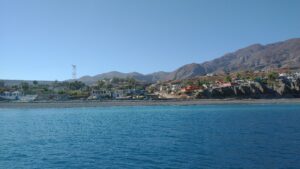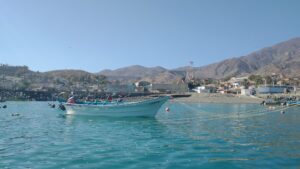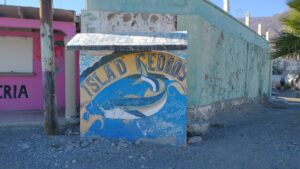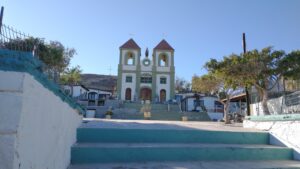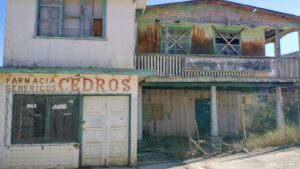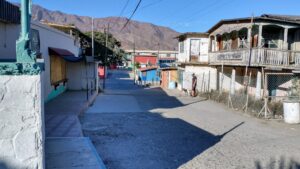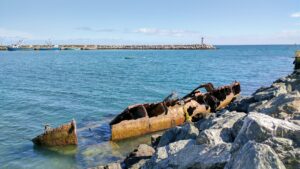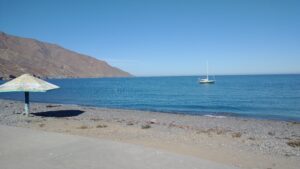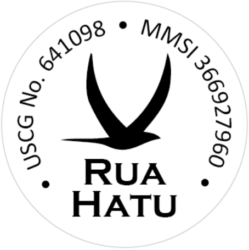It was late December and we dropped anchor near a small fishing village. The sleepy village lies at the foot of a 750 meter tall old volcano. Rust, orange, and sand colors prevail with grey streaks resembling ash avalanches long ago rolling down the hills of Isla de Cedros.
We must have anchored in front of the main beach of this village as you could distinguish faded murals and worn parasols lining the beach promenade. A large sign stated “Club Boulevard 24” hinting at this location being occupied with beach goers in the summer months. The water here is clear and bright blue but unfortunately too cold for a comfortable swim. We anchored in about 10 meters but the surf stirs up too much silt to be able to see the bottom. This silt is what made me stop and admire the water’s beautiful turquoise color near the beach for a long moment.
After stowing the sails we set out to explore the village. We decided against a beach landing as we had read the harbor has dinghy tie-ups. Loaded onto the dinghy we followed the breakwater just south of where we anchored, perpendicular to the shore. The entrance to the town harbor is marked by two tall rusty steel towers. Red on the north and green on the south entrance. The rocks were covered in white and brown pelicans and various types of sea gulls. As we entered the harbor a sealion stuck its head out of the wake our dinghy created behind us. We slowly moved through the harbor bay on the right passing a concrete peer with a Mexican Navy Coast Guard boat and two island supply ships. Everyone waved back at us as we passed the dock. On the left is an old wooden boardwalk that still hosts fishing shacks and small cranes to unload the small 10 meter long brightly colored open fishing boats. The pelicans lined up on the end of the dilapidated boardwalk, on other fishing boats, or hovered on tie-up lines, waiting for handouts from the fishermen. Occasionally you could see a sealion peaking up next to the fishing boat in hopes for a delicious snack.
Despite being early winter with a crisp breeze occasionally cooling your skin, the sun was hot. I tried to imagine being here in summer under the searing heat. After tying up the dinghy we took a walk through the dusty streets of town, a few designated boulevards were concrete paved but most other roads were either dirt or pebble stone covered. We followed the beach boulevard lined with faded beach huts painted with colorful murals that mirrored the many colors of the houses on the hillsides. We continued boulevard that had now turned into a dirt road up the hill into town and were greeted by a group of wagging and barking dogs. Everybody had to sniff Kiwi and then followed us a little way up the road until the scattered back to their respective homes. We noticed many cute little houses with beautiful bougainvillea vines and fruit trees growing inside their compounds. Children would occasionally peek out of windows or out from behind houses to see what the dogs were barking about and then would coming running to point at Kiwi exclaiming “Perro lindo!”, “Cute dog!”. The town had a few stores with sparse, but sufficient basic offerings. Of course, beer was also one of those basic offerings.
After stoking up we walked back to the beach and explored the hillsides. We spotted a group of geese swimming in the surf and Kiwi immediately took after them. We had a group of three or four ravens follow us down the beach landing on the porous cliffs above us and causing sand, rocks, and shells to rain down on us, followed by a chuckle of the raven. The beach was lined with beautiful cone shaped shells, whose meat we later found for sale in cans at Bahia Tortuga. We have yet to find out how to prepare and eat them. Further down the beach the trail began taking us up above the cliffs and into natural culverts that seem to be the runoff drains during large rainstorms. The sides of these drains slice through the cliffs and you can see many beautiful rocks and shells that were encased in sand a long, long time ago and now erode back away into the ocean. Higher up we spotted red flowering barrel cacti and various other succulents and cacti.
Back at the boat we prepared to grill the bonito fish we caught the day before. With a red colored sunset in the background we enjoyed grilled fish tacos with chipotle coleslaw, salsa, avocado, and, of course, a cold beer listening to the pebbles rolling in the surf. We stayed here at Isla de Cedros another two nights before we continued on to Bahia Tortugas.
